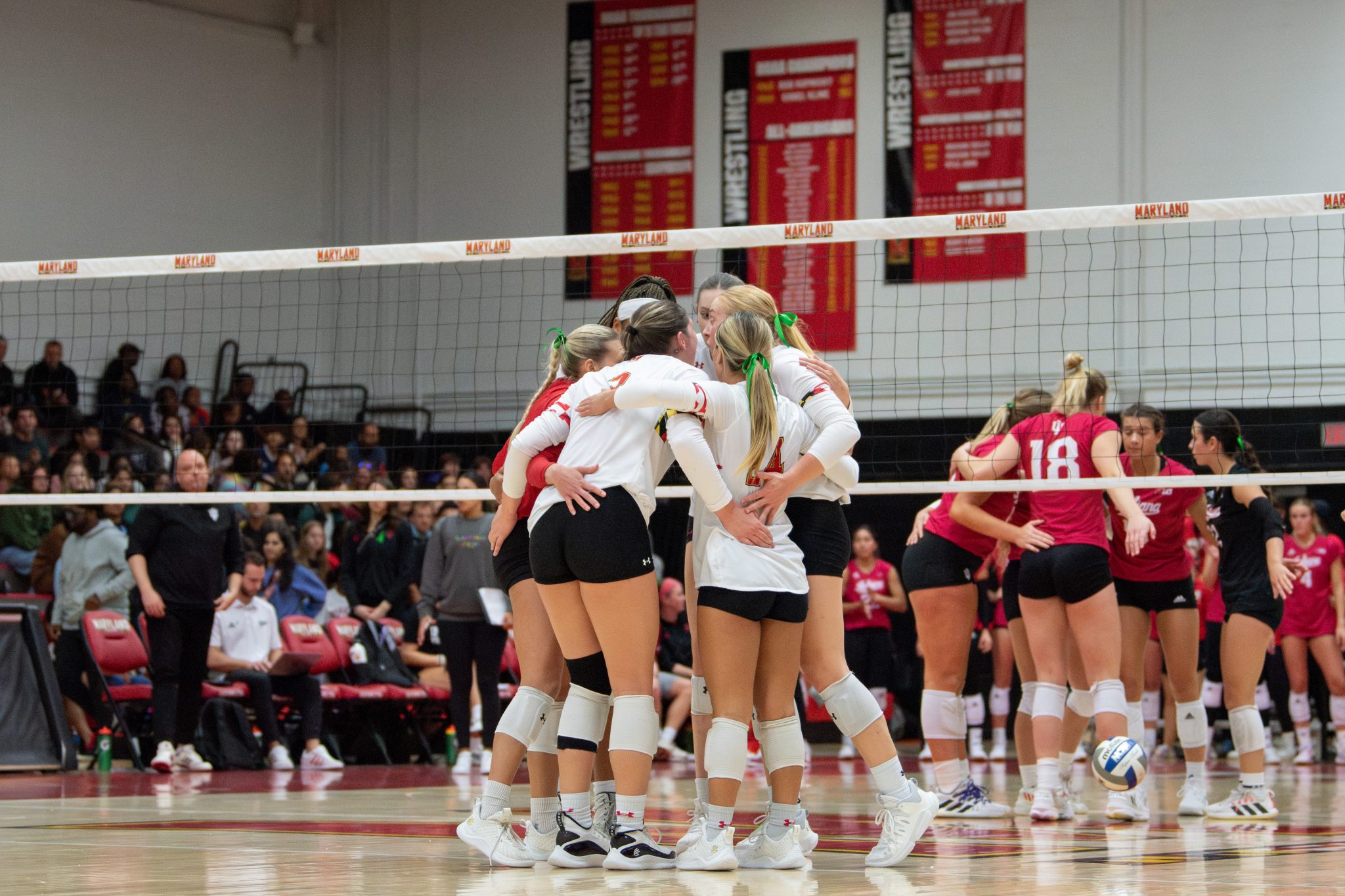Maryland volleyball entered the 2023 season primed to take another step toward fulfilling coach Adam Hughes’ vision of building the Terps into an elite program.
Maryland finished at least .500 and notched seven Big Ten wins in both 2021 and 2022. A better conference record or a long-awaited return to the NCAA tournament in 2023 could have represented significant strides toward Hughes’ aspirations.
The Terps continued to establish consistency with their 2023 campaign, finishing 17-15 and winning seven Big Ten matches for the third straight year. But scrapping just above .500 wasn’t the outcome Hughes and the program had hoped for.
“The good news is we’re disappointed with a 17-15 record,” Hughes said after Maryland’s 3-2 win over Rutgers in the Terps’ season finale on Nov. 24. “It wasn’t always that way … I finally feel like we’ve got a squad that can continue to say, ‘Hey, being above .500 is not OK.’ And to me, I want to raise the bar.”
Maryland’s 2023 season unfolded similarly to its previous two campaigns. Hughes’ squad flourished throughout its 12-game nonconference slate before gradually regressing amid a challenging 20-game Big Ten schedule that featured seven matches against teams qualified for this year’s NCAA tournament.
The Terps’ lone win of those seven tests was their most impressive victory this year. Maryland upset then-No. 16 Minnesota in five sets on Oct. 6 in College Park, the Terps’ first-ever win against the Golden Gophers in 19 matchups.
“Everybody all around did a good job of being calm, disciplined, steady and taking care,” setter Sydney Dowler said after the win.
Maryland’s upset propelled it to 3-2 in conference play, the program’s best-ever five-game start in Big Ten action.
But the Terps’ promising season quickly spiraled.
[Maryland volleyball defeats Rutgers, 3-2, in regular season finale]
Maryland fell to Indiana a night after defeating Minnesota, the first of four straight losses that ultimately submerged the Terps to below .500 in league play for the rest of the season.
Hughes’ squad was swept 10 times in 2023, twice as often as it was the season before. Maryland lost 11 of its final 15 games and missed the NCAA tournament for the 18th straight year.
“It just was a little frustrating that we tried some new things and ended up kind of in a similar spot,” Hughes said after the season.
The Terps’ biggest experiment was their new approach on defense. Maryland had asserted itself as one of the country’s stingiest teams at the net, having led the NCAA in blocking in 2021 and 2022.
But after Rainelle Jones, the Terps’ all-time leading blocker, graduated following the 2022 season, Maryland focused on becoming a more well-rounded defensive team in 2023.
The Terps aimed to rely more on digs this season and often served aggressively to keep opposing offenses out of rhythm. Their adjusted approach didn’t yield much improvement. Maryland expectedly regressed in blocks per set this season, but the Terps also registered 0.7 fewer digs per set and committed 0.5 more service errors per set.
Maryland’s weaker defensive numbers were rooted in the team’s inconsistent serve receive, an area where Hughes said the team can make “massive” improvements next year.
The Terps surrendered the second-most aces per set in the Big Ten during conference play. Maryland’s struggles in serve receive also limited its ability to generate competitive attacks on offense.
Opponents easily steadied the Terps’ low-quality shots, which helped them mount in-rhythm attacks against Maryland’s block. Big Ten teams hit .226 against the Terps in 2023, up from .198 a season ago.
Applying more pressure on offense to force opponents out of their rhythm will be critical for Maryland next season, Hughes said.
“Better offense leads to better defensive opportunities, and in return gives us probably better offensive opportunities,” he said. “It’s like a giant circle.”
[Maryland volleyball drops penultimate game of regular season to No. 14 Penn State, 3-0]
The Terps relied on a more balanced attack this season than in previous years. Nine players registered more than 50 kills for Maryland in 2023, up from six players a season ago.
Seniors Sam Csire and Samantha Schnitta led the team with 272 and 223 putaways, respectively, but the Terps struggled to find a go-to scorer in high-leverage situations.
“We got to find some more points for sure,” Hughes said. “We’re looking for probably three [outside hitters] to all have about three kills [per set] apiece.”
Defensively, middle blockers Anastasia Russ and Eva Rohrbach each tallied more than 100 rejections even as Maryland slipped to 46th among Division I programs in blocks per set. Libero Lilly Gunter anchored the Terps’ back row — the Mississippi State transfer’s 3.69 digs per set were seventh-most in the Big Ten.
This year marks the first time since between 2003 and 2005 that Maryland has finished .500 or better in three consecutive seasons. But building on that stability will be challenging once the Big Ten welcomes UCLA, Oregon, Washington and USC from the Pac-12 in 2024.
Oregon and USC qualified for this season’s NCAA tournament, while Washington had reached the postseason 21 years straight before missing out in 2023. UCLA has made the tournament seven times since 2013.
For Hughes, a tougher conference slate offers Maryland more opportunities to build on its stability and challenge the elite programs among which the Terps soon hope to be recognized. It also will make it harder for Maryland to reach Hughes’ lofty ambitions, ones the Terps have yet to meet.
“I don’t want an easier path,” Hughes said. “I don’t think they’ve made it a safer path for us. But we’ll find a way. That’s what we always do.”



